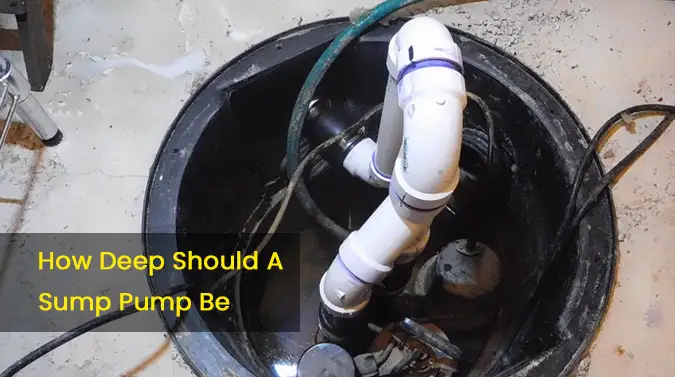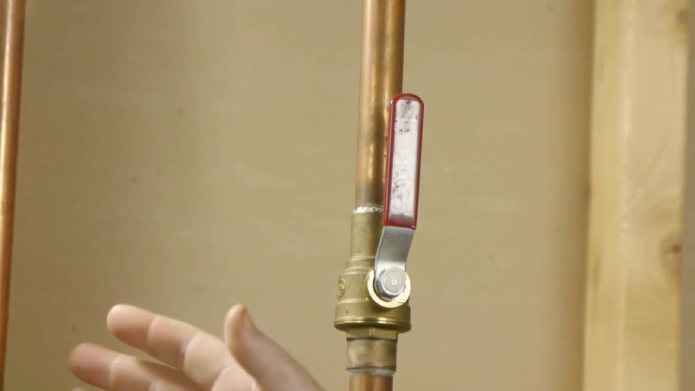Last Updated on July 16, 2023
If you’re thinking about installing a sump pump, you’re likely wondering how deep the pit should be, and you’re not alone. Really, it depends. There are a few factors to consider, like the size of the building and the location of the property.
But generally, you should make sure the pit is at least 24 inches deep and 18 inches in diameter. That way, you can rest easy knowing it will hold enough water to prevent the pump from cycling too frequently.
Of course, depending on where you live, standard building codes may require a minimum depth of 30 inches or even recommend a deeper pit of up to 36 inches.
In some cases, like in large commercial buildings, the sump can be as deep as 10 feet below the level of the basement floor and 8 feet in diameter.
Take a dive into the depths of sump pump pits. Discover what factors affect their size and learn how to construct your own.
How Deep Should a Sump Pump Be: Factors That Determine

Your sump pump’s depth isn’t a one-size fits all type of equation. Everything from local building code requirements to the specific conditions of your property can influence how deep you need it dug. Talk about an underground adventure.
So before taking out that shovel, familiarize yourself with these criteria. They’ll be key in determining the correct pit length for maximum protection.
1. Proximity to a Water Source
The sump pump pit’s depth depends on its proximity to a water source, such as a river or creek. If the home is located near a water source, the sump pump pit may need to be deeper to handle a higher volume of water in case of flooding.
In such situations, the pit should be dug deep enough to ensure that water does not overflow and flood the basement or crawl space.
It’s important to note that the pit’s depth will also depend on the elevation of the water source. If the water source is at a higher elevation than the sump pump pit, then a deeper pit will be necessary to pump out the accumulated water effectively.
2. GPM of Typical Rainwater
The gallons per minute (GPM) of typical rainwater that enters the sump pump pit is a major factor in determining the pit’s depth. The higher the GPM, the larger and deeper the pit needs to be so that it can handle the increased water flow.
In general, an average residential sump pump pit should have a minimum depth of 26 inches and a maximum depth of 36 inches to ensure proper function and basement waterproofing. If a larger sump pump is required due to higher GPM, then a deeper hole will be necessary to accommodate it.
3. Diameter of the Hole
The diameter of the hole is another important factor in determining the sump pump pit depth. A larger diameter hole will allow for a larger sump pump pit insert that can handle more water.
Generally, an 18 to 30-inch diameter hole is suitable for residential use and will comfortably accommodate most sump pumps on the market today.
4. Horsepower of the Pump

The horsepower of the sump pump is an important thing to know. Higher horsepower means more pumping capacity, which can handle deeper pits.
If you have a smaller horsepower pump, you may need a shallower pit since it may not handle pumping water from deeper pits efficiently.
It is important to consider the extent of your water problem and select the right horsepower for your pit’s depth. By doing so, you can prevent potential problems such as overheating or pump failure.
5. Vertical Lift of the Discharge
The vertical lift on the discharge pipe is another crucial factor in determining the depth of the sump pump pit. To move the water up, you need a powerful pump with a high discharge lift. Therefore, a deeper pit is usually required, as it offers more room for the pump to function.
Installing a pump in a shallow pit may lead to insufficient space, which will limit the pump’s lifting ability, which can damage the device, resulting in frequent repairs and replacement.
6. Depth of the Pump In the Hole
The depth at which the sump pump is installed in the pit is a significant factor in figuring out the depth of the overall pit.
It is preferable to install your pump at a depth that will allow it to function effectively but not buried too deep that it’s challenging to maintain.
If the pump is installed too high, it may not be able to pump all the water from the pit effectively. On the other hand, if installed too low, the pump must work harder and may fail quickly because of heat issues.
Therefore, it is necessary to determine the optimal location for the pump in the sump pit beforehand so that the depth of the pit does not have to be changed later on.
How Do You Make a Sump Pit?

Ready to roll up your sleeves and get down and dirty? Let’s make this sump pit from scratch. Follow these easy steps, then let the building begin.
Step 1: Trace the Outline of the Sump Liner
To create an immaculate sump pit, start by grabbing a marker and tracing the outline of your liner. Taking time to ensure that you leave at least 3-4 inches around it will help guarantee an impeccable fit with no gaps or overlaps.
Step 2: Remove the Concrete Floor
To remove the concrete floor there are a few steps to follow. First, rent an electric jackhammer or use a hammer drill rigged with a masonry bit, a good sledgehammer, and a chisel.
Next, cut the concrete floor into manageable pieces, making sure not to shred it. The jackhammer should be moved at an angle to pry up the pieces and remove them from the area. This will ensure that the concrete is broken up effectively without causing damage to the remaining portions.
Step 3: Dig the Sump Hole
Digging the sump hole involves several steps. First, dig the sump hole at least 12 inches deeper than the sump liner. Shovels and spades may be used, but using a mechanical digger is more efficient.
Use 5-gallon buckets to cart the debris outside. To ensure stability for the sump liner, place coarse gravel in the bottom of the hole so that the sump liner sits flush with the basement floor when placed in the task.
A level should be used to ensure that everything is even and in place, and the gravel should be tamped down firmly to provide a stable base for the sump pit.
Step 4: Drill Holes In the Sump Liner (If Necessary)
Depending on the liner used, drill numerous holes in the sump liner to allow water to enter so the pump can pump it away. The size of holes should be smaller in diameter than the size of the gravel used so that gravel does not come through.
The number and location of the holes will vary depending on the specific sump liner being used.
Step 5: Seat the Liner In the Hole

For the liner to sit in the hole, place it carefully in the center of the hole. Then, place gravel around the sides of the sump liner, coming up to about 6 inches below the level of the floor.
The gravel between 3/8 and 1/2 inch is fine. This will help to stabilize the liner and prevent it from shifting over time. Once the liner is in place, test the pump to ensure that it is working correctly.
Step 6: Concrete Back Over the Floor
Now it is time to give your sump pit the finishing touch. Mix up some concrete and pour it over the gravel, filling in everything until it meets with the edge of your trusty liner.
Smooth out any rough spots using a trowel before you take a break. Let that mixture harden for around 8 hours so all of those little details can settle down into place perfectly.
Does a Sump Pump Pit Need to Be Vented?
It is highly recommended to vent a sump pump pit. This will remove hazardous gases such as carbon monoxide, methane or even radon that could build up in your living space from fresh groundwater entering and standing water settling inside the pit.
Plus, this helps reduce moisture intrusion leading to any potential damage down the line, not something you want.
Should the Sump Pump Sit on Bricks?

Placing a sump pump on steady, flat bricks rather than sitting it on debris such as silt or gravel is recommended. If debris gets sucked up into the pump, it can damage the motor and cause malfunctions.
Using bricks ensures that the pump has a secure and stable foundation. Additionally, it is important to have a filter fabric around the sump basin to prevent debris from entering and causing damage. This fabric acts as a protective barrier, stopping materials from clogging or damaging the pump.
Build A Right Depth Sump Pit And Protect Your Property From Floods
Sump pumps protect your property from flood damage. The ideal pit depth should be a minimum of 18 inches wide and 24 inches deep.
However, factors like property location, building size, and expected water volume must be considered to determine the appropriate pit depth.
Adhering to building codes and regulations is also critical in ensuring that the installation is safe and efficient. By considering these factors, you can enjoy your sump pump’s excellent protection.



